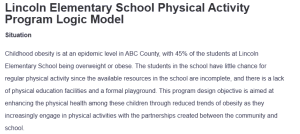Lincoln Elementary School Physical Activity Program Logic Model
Situation
Childhood obesity is at an epidemic level in ABC County, with 45% of the students at Lincoln Elementary School being overweight or obese. The students in the school have little chance for regular physical activity since the available resources in the school are incomplete, and there is a lack of physical education facilities and a formal playground. This program design objective is aimed at enhancing the physical health among these children through reduced trends of obesity as they increasingly engage in physical activities with the partnerships created between the community and school.
Objectives
- Increase participation in physical activities: 60% of students take part in physical activities at least three times a week by the end of the first year.
- Educate parents and teachers by conducting quarterly workshops that would raise awareness about the benefits of physical activity to reduce childhood obesity.
- Community build: Hold community events every month to engage children and their parents in physical activities.
- Reduce the rate of obesity: To reduce obesity rates among the participating students by 10% for three years.
| Inputs | Outputs |
Outcomes — Impact |
||||||
| Activities | Participation |
Short |
Medium |
Long |
||||
| Personnel: Health educators, volunteers, local exercise specialists
Resources Needed: Funding from local health agencies, grants for playground equipment, community donations
Facilities: Open space behind Lincoln Elementary, possibly shared use with local recreational facilities (Wyszyńska et al., 2020).
Partnerships: Working in collaboration with local health departments, non-profit organizations and community centers
Curriculum: Evidence-based physical activity guidelines for children |
Playground Equipment Installation: Design an interactive and safe play zone for kids using the open area of the school.
Organize sessions weekly: Physical Education weekly sessions of games and exercise schedules (Smith et al., 2020).
Parental Involvement Programs: Engage parents with education on supporting their children in physical activity outside of the school setting.
Teacher Training: This would further equip teachers with the ability to fit periodic bouts of physical activity into any classroom routine.
Community Events: Organize monthly physical activity events and sensitize the community on the essence of a healthy lifestyle. |
Students: There will be a total of 300 students in grades pre-kindergarten through 4th grade who will be involved in organized physical activities.
Parents: Many information sessions regarding obesity prevention can be motivated, where participation from parents is invited (Wyszyńska et al., 2020).
Community: Training provided by local volunteers and organizations ensures ownership by the community.
|
Increased Physical Activity: Students are involved in organized physical activities on a weekly basis for 60%.
Better Knowledge: Parents and teachers develop awareness about the prevention of obesity and the role of physical activity in child health. |
Improved Health Behaviors: The percentage of students who report regular physical activity increases to 70% among participating students.
Parental Involvement: The percentage of parents who report that they have become more supportive of their children’s physical activities at home increases to 50%. |
Reduced Prevalence of Obesity: Obesity rates decline by 10% among students within three years.
Sustained Physical Activity: School combines physical activities with lessons that promote healthy life habits. |
|||
| Assumptions | External Factors | |
| The school administration actively supports the program as well as the community.
The financial budget for both equipment and activities shall be sufficient and continuous. Parents will reinforce and support home-based physical activities. |
Socioeconomic conditions whereby high poverty might influence the level of involvement by the parents and the investment of resources.
Policy Support: Local policies may influence the budgetary allowance that a school may or may not spend on health programs. Environmental Factors: Seasonal weather may influence the ability or desire to participate in outdoor activities. |
References
Smith, J. D., Fu, E., & Kobayashi, M. A. (2020). Prevention and management of childhood obesity and its psychological and health comorbidities. Annual Review of Clinical Psychology, 16(1), 351–378. https://doi.org/10.1146/annurev-clinpsy-100219-060201
Wyszyńska, J., Ring-Dimitriou, S., Thivel, D., Weghuber, D., Hadjipanayis, A., Grossman, Z., Ross-Russell, R., Dereń, K., & Mazur, A. (2020). Physical activity in the prevention of childhood obesity: The position of the European childhood obesity group and the European Academy of Pediatrics. Frontiers in Pediatrics, 8(1). https://doi.org/10.3389/fped.2020.535705
ORDER A PLAGIARISM-FREE PAPER HERE
We’ll write everything from scratch
Question
PH 505
Logic Model Case Study
One in seven low-income, preschool-aged children in the US is obese (CDC, 2020). In addition, nearly 19% of US children are obese (CDC, 2020). Childhood obesity is one of the leading public health concerns and disproportionately affects low-income children. Being obese as a child also increases the likelihood of being obese as an adolescent or adult (CDC, 2020). This puts children at risk for developing several chronic diseases, including diabetes, asthma and hypertension.
In ABC County, there is a high poverty rate and 27% of the community is obese. Additionally, 45% of school-aged children are either overweight or obese. You are a health educator who has been assigned with the task of decreasing childhood obesity rates by collaborating with Lincoln Elementary School in ABC County. The school has 300 students from pre-kindergarten through 4th grade, all of whom have limited access to quality physical education programming. Lacking basic essentials, such as a physical education teacher and gymnasium, the children are already at a disadvantage. However, the school has a large open space behind the main building but no formal playground.

Lincoln Elementary School Physical Activity Program Logic Model
Regular physical activity contributes to obesity prevention. The availability of quality and safe recreation areas play pivotal roles in physical activity behaviors in children. The goal of your program is to improve the overall health and wellbeing of elementary school children in ABC County as measured by participation in physical activity either during or after school.
- Briefly write 3-4 objectives to increase physical activity for children at Lincoln Elementary School.
- Develop a logic model to illustrate your program.

